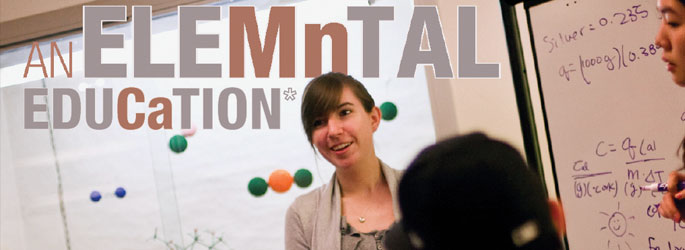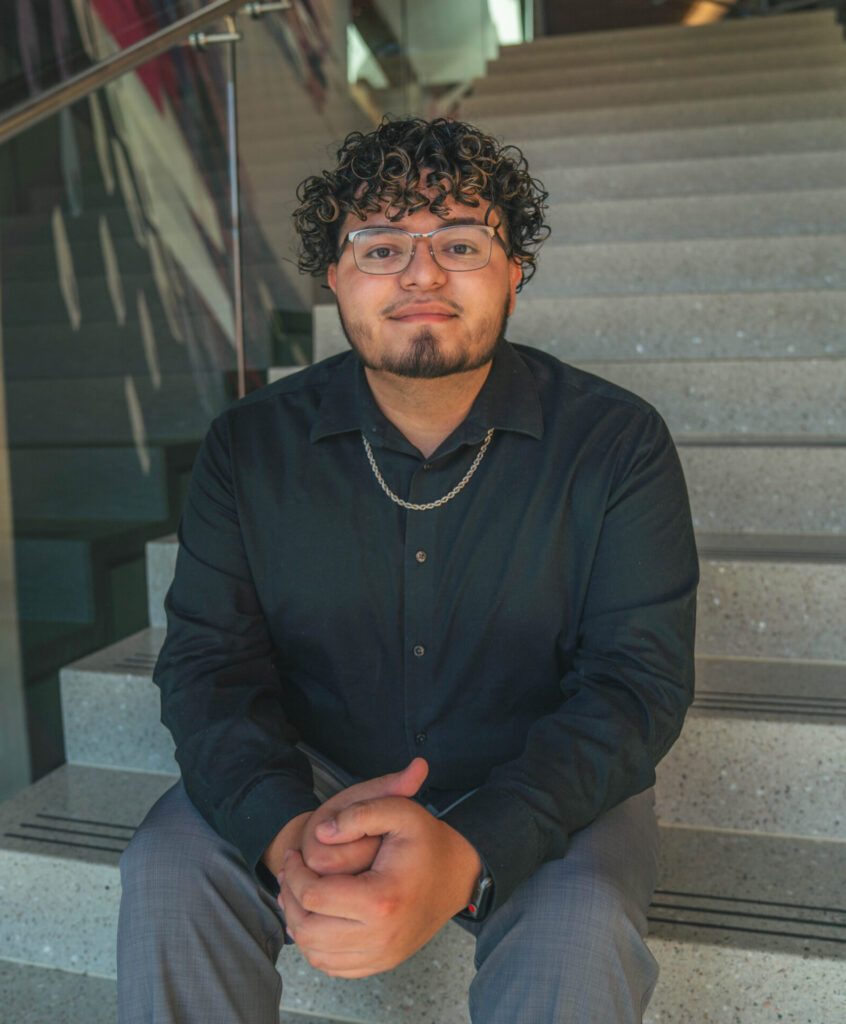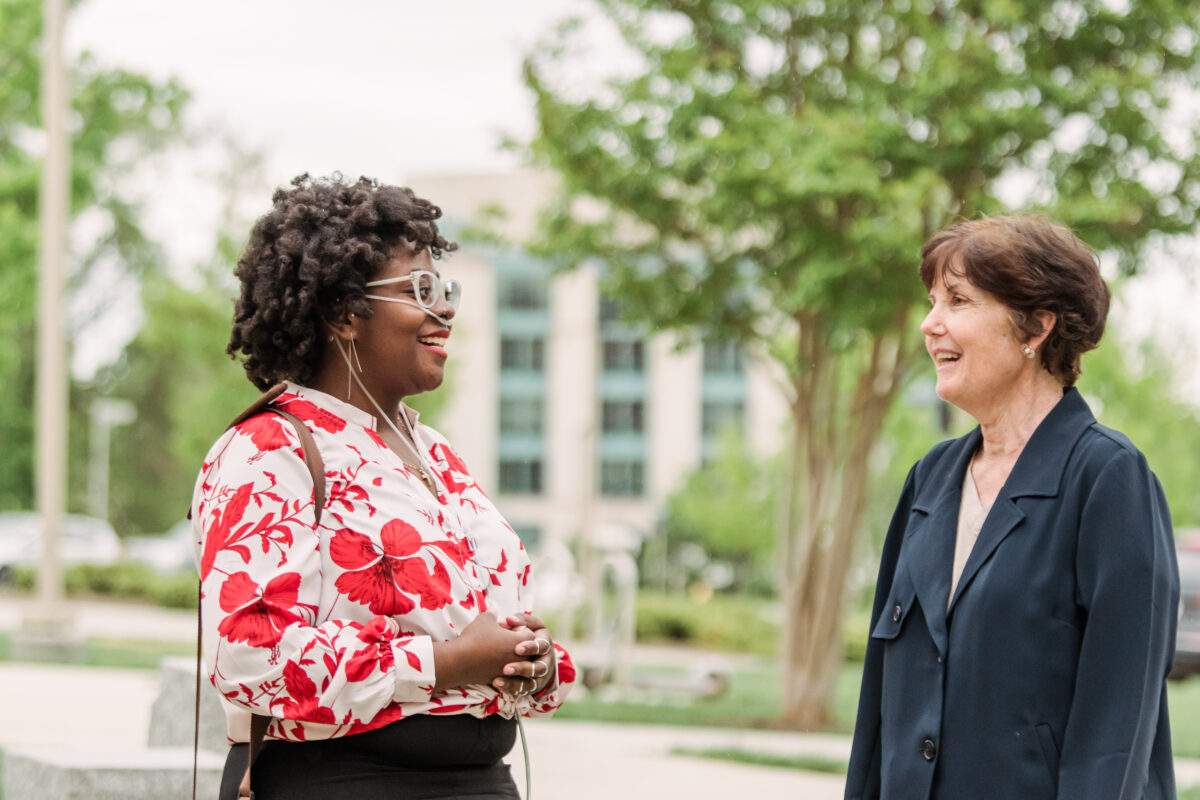Spend a semester inside UMBC’s pioneering Chemistry Discovery Center and you’ll find that its successes are rooted in teamwork – and two hours a week without Twitter and Twinkies.
By Ann Griswold
Photos Chris Hartlove
Think Chemistry 101 is hard? A few years ago, Bill LaCourse, chair of UMBC’s chemistry department, devised a way to simultaneously make it seem harder.
He called his invention the “Chemistry Discovery Center.” Students call it “the isolation tank” or “boot camp.”
LaCourse’s brainstorm is housed in a brightly-lit room on the second floor University Center – just a horseshoe toss from the chemistry department’s offices. For two hours every week, the students who enter it abandon all hope of food and drink, texting and web-surfing, Twitter and Facebook.
Their full attention is on chemistry – and in particular – thinking and talking about chemistry. “The idea is to get them in there to share their collective thoughts,” says LaCourse. “Give them roles to perform, take away their pads and pencils and make them talk.”
Complaints about the rules and rationale abound. The center is a waste of time, some students say. Others argue that they could solve the assigned problems in 45 minutes if left to their own devices.
LaCourse deflects the gripes with two words: “It works.” And he has the numbers to prove it.
In its five years of operation, the Chemistry Discovery Center has helped slash the failure rate for Chemistry 101 by half. But it has done more. Grades among students at all levels are up, even after the department raised the grading standards. (See page 21.) And the number of UMBC undergraduates who choose chemistry as their major has also dramatically increased.
In the spring 2010 semester, I followed one group of students through the Chemistry Discovery Center experience. My question was simple: How does a weekly plunge into a world without social media and snacking create better – and more – chemistry students?
February 3, 2010
The campus is still buried in snow when students trudge into the center, wearing heavy coats and scarves. It’s their first day, and most of them look as if they’d rather be outside sledding.
Diana Hamilton, a lecturer in the Chemistry Department, explains how the center works to the 72 students in attendance. Teams are created from four students. Each team member is assigned a role, which shifts every few weeks. A “blogger” types the group’s answers on a keyboard. (These responses are conveyed to a computer used by Hamilton.) A “scribe” jots the team’s calculations on a whiteboard. A “researcher” uses a calculator to manage the math.
The final team member is a “manager” who keeps the group focused and enforces the Chemistry Discovery Center’s rules. (Breaking them costs the team valuable points.) “Managers aren’t typing or drawing,” Hamilton says, “but your brains should be actively involved…. If we come by, you should be able to give us a quick rundown on what the team is doing.”
The first task? A set of chemistry problems based on an hour-long lecture students attended earlier that morning.
The members of Team Nitrogen are already struggling with their new roles. Most of the answers are provided by Brennen Cheung, a chemical engineering major who acts as the manager. Kuntal Patel, a pajama pant-clad psychology major who ambled into the center late, yawns, tilts back in his chair and stares into midair.
“You have to write that on the board,” Cheung says to Patel, who looks up. “Question three,” Cheung repeats.
“You have to write the answer on the board.” Patel swivels his chair and leans over to grab the dry-erase marker. “No,” Cheung says. “Take out the ‘S’ and put an ‘R.’”
Hamilton circulates among the students, stopping here and there to read the answers scribbled on each group’s whiteboard. At one point, she freezes the students’ monitors and calls for attention. “A lot of you seem to be having trouble with question three,” she says. Hamilton explains the problem and drops a few hints to steer the teams back on track.
By the end of the first session, the groups have picked up the momentum of solving problems as teams. But many are hesitant to admit the session was anything but tedious.
Jennifer Fedorowski, a third-year graduate student and teaching assistant, says it takes a few weeks before students realize that the benefits reaped from the Discovery Center depend largely on the energy they put into it. “The students on their first day need to be pushed,” she says. “In the second or third week, we hardly ever have any issues.”
March 3, 2010
It’s a wet morning a few days before the first exam, and the students wear anxious looks. Seven of them dropped the class after the first week, and several more wonder if they should follow suit.
“Just for this time, we’re going to look at some of the stuff you need to know on Friday,” Hamilton announces. The review session takes the form of a game: questions pop up on each team’s monitor and the students scramble for answers.
Team Nitrogen’s table remains empty until 10 minutes after the hour, when Kuntal Patel ambles through the door. “I think our other dudes dropped,” he says, falling into a chair at an empty table. Hamilton steers him into a seat at Team Gold’s table, where he take on the blogger’s role.
It’s a good match. Patel is already engaged by the time the next question pops up: “Your biodiesel car gets 48 miles per gallon. Biodiesel’s energy density is 127,000 Btu per gallon. If 1 Btu = 1055 Joules, how many kilojoules would be produced by travelling 250 miles?”
“You gotta do the…” Patel begins, before his teammates finish reading the question.
“…dimensional analysis,” finishes Michael Criswell, a returning student with a bachelor’s degree in theatre arts who is here to brush up on chemistry for his MCATs.
“I knew it started with a ‘d’,” Patel says, searching for the calculator. “Do 48 times 120,000 times 655 times 250 times 10 to the minus three.”
The teams grapple with the review questions. It’s a messy process. Sometimes a blogger abandons the calculator and grabs a dry-erase pen. Hamilton watches to see if the teams adhere to the rules. At one point, she stands behind Criswell and peers over his shoulder at the group’s answers.
“It’s terribly frightening to have you here,” Criswell says. “It’s like Darth Vader in the academy for the storm troopers.”
“I’m sorry I make you feel that way,” Hamilton laughs. She points out an error in their calculations before moving on to the next table.
If the center’s goal is to get students to puzzle through chemistry together, however, it’s working as intended today.
Hamilton offers to stay afterwards, but everyone seems eager to leave when the session is over. Outside in the courtyard, the students seem confident about the upcoming exam.
“Discovery Center is the reason I’m going to pass chemistry,” Criswell says. “They actually hold your hand and walk you through it. It’s ingenious, actually.”
Necessity and Invention
The Chemistry Discovery Center’s founder says that it was an invention born out of necessity.
Only a few years ago, LaCourse recalls, introductory chemistry at UMBC was in a downward spiral. Fewer and fewer students attended classes. Exam scores had plummeted. Student discontent became so loud that even the university’s administration took note. Something had to change, and fast.
UMBC’s academic leadership had already made student retention and success a university-wide priority. And the Chemistry Discovery Center was one key part of the strategy to improve the university’s success.
LaCourse took his cue for creating the center from the Massachusetts Institute of Technology and a host of smaller colleges that were attempting to revolutionize science education by using an approach called “constructivism” – encouraging students to learn by doing and share their knowledge with each other.
Other schools experimenting with this approach were moving slowly, with pilot programs and small groups of students. But the challenges facing UMBC compelled LaCourse to move faster.
“We were failing and we didn’t want to subject anyone to a placebo,” says LaCourse. “Our GPA average was going down; you had to keep lowering the cutoffs to get the same percentage of people passing. So we just went out and tried it.”
So LaCourse and his colleagues dismantled and rebuilt UMBC’s introductory chemistry program. Gone were antiquated discussion rooms and laboratory benches. They also ditched a method of instruction that saw students muddle through problem sets on their own and bring them back to large discussions groups where a teaching assistant simply announced the answers.
“You’d have 90 kids in a discussion group,” LaCourse recalls. “The alpha people in there were getting the answers they wanted, but students who were a bit shy or overburdened with other things were left behind.”
The lectures have remained, but a room with tables and intensive small-group interaction (without the distractions of snacking and social media websites) replaced the discussions. LaCourse and his colleagues sought to level the playing field and engage even the most introverted students.
The center also works because it helps students overcome barriers that prevent them from grasping the concepts of what LaCourse calls an ‘invisible’ science. “The [periodic] table is full of atoms; you’ve got millions of them in your hand. You can’t see them,” he says. “If you’re studying chimpanzees, you can see their behavior. But how do you see the behavior of a molecule? That’s the trouble.”
In the Chemistry Discovery Center, he says, the problem sets often ask students to contemplate more tangible concepts like how the molecules swirling in their morning coffee react with air to give the drink its bitter taste.
“At some point, you make the connection,” LaCourse says. “The things you see around you now become explainable.”
April 7, 2010
White cherry blossoms adorn the branches of a tree outside the Chemistry Discovery Center’s windows. The theme of today’s problem set is food. “If you can cook, you can do chemistry,” says Hamilton. “And if you can do chemistry, you can cook.”
Patel is a bit lost. He’s been shunted to a less-enthusiastic group, and he spends some of his time exploring the limits of the group’s computer. Despite the risk of losing points, Patel pokes around to see how computer applications are actually off limits. Annoyed that the team’s researcher is not using the calculator on the table, Patel opens the calculator application in the computer’s Accessories folder, only to elicit an error message: “UTILITY BLOCKED.”
“Aww, bastard!” he mutters. “Someone type in 144 divided by 8.” No one picks up the calculator. No one stands at the whiteboard. Patel’s teammates also won’t discuss the answers out loud, so he does a lot of thinking and typing. His frustration is palpable.
“The atmosphere definitely feels like a high school environment where you’re heavily monitored to stay on task,” Patel says, bemoaning the strictness of the rules.
“Stand up, stand up,” Hamilton says, striding briskly past the team’s table and snapping her fingers at the member who has been designated as the scribe. “If you need to, go splash water on your face. Wake up.”
It’s times like these – when hunger, fatigue and restlessness set in before the session is even halfway over – that the urges to ignore chemistry and doodle on a notepad are most compelling. Which is precisely why laptops, iPods and cell phones are prohibited. Distractions dissipate the energy, particularly in groups where the energy level is already lacking.
“Edutainment – that’s not what we’re going for,” says LaCourse.
Over at the next table, Criswell is part of an animated and jovial Team Mercury. He punches numbers into the calculator as the team’s blogger, Ed Kim, types the group’s answers on the keyboard. Freshman Dena Lehmann jots down calculations on the whiteboard enthusiastically.
“We are destroying this,” says Criswell, pleased with his current teammates and thankful that – at least for now – he’s not stuck in a group where no one speaks.
“So much of it depends on the synergy,” Criswell says later, empathizing with Patel’s plight. “I was in a couple of groups where they were just like toast. There was nothing exciting about them. The best group I had was my first group because there was a large spectrum of personalities. There would be an obnoxious person, and a super nerd that wanted to get 100 percent on the test and was really anxious about the material, and someone who knew it well and was just really relaxed about it, and that was Kuntal [Patel].”
Hamilton says that she is not surprised by the contrast. In groups where everyone works well together, the session moves quickly and everyone has fun. But that’s not always the case.
“With so many students, I’ve seen it all,” Hamilton says. “Some students, you can tell they’d rather work alone. They’re either too competitive or not comfortable in social situations. But some just seem to be natural tutors, whatever role they play. And other people, you can see they’re smart; they can do chemistry and they understand. Kuntal seems like that. No matter what the context, other students can get along with him.”
May 12, 2010
It’s the last session of the semester. Attendance is uncharacteristically low, with many students cramming for finals in other courses. “Hopefully we’ll have some more people coming in shortly,” Hamilton says. “Otherwise we’ll have to shuffle people around to fill the tables.”
The session starts off with a quick game to review the material. Patel, who is a scribe for Team Noble Gases, madly writes the complete electron configuration of lead on the whiteboard, hoping to be the first to arrive at the answer: 1s22s22p63s23p64s23d104p65s24d105p66s25d106p67s24f4…
“How far am I?” he asks.
“Almost done,” says the manager, a sophomore named Andrea Mancilla.
“I’m going to need the whole board for this,” Patel sighs. “What’s the next question?”
“What is the complete electron configuration of the cation that formed the solid lead iodide?” Mancilla reads.
“Agh! Now I have to do iodide?” Patel asks. “Are you serious?”
But before he can start, Hamilton freezes the monitors and congratulates Team Cadmium for arriving at the right answer.
“They got it,” Mancilla says, shaking her head.
Patel’s disappointment is short-lived: Noble Gases win the next round. In retrospect, he says his experience with the Discovery Center wasn’t all bad. The real-world examples it offered and the teamwork approach helped him nail down important concepts.
“It’s not about getting it in your head, it’s about getting it back out,” Patel says. “You’re not going to understand something until you actually apply it or at least recite it.”
So what happens to the UMBC chemistry students who survive the rigors of the center – and the gnawing absence of websites, texting and snacks? In most cases, they thrive. More than 80 percent of the students I followed earned a grade of ‘C’ or better. And true to the statistics, some of the students did decide to become chemistry majors. Among them, Patel, who earned a high B in the course.
Still, he laughs when asked if the Chemistry Discovery Center influenced his decision to double-major in chemistry and psychology. “Oh no, absolutely not,” he says. “I’ll put it this way. At the end of the day, it’s a two-hour session and no one really wants to do it. People I’ve talked to pretty much unanimously say it’s torture. But whether you want to do it or not, it’s a mandatory component of Chem 101, so I just did the best I could with what they gave me.”
Patel may deny that the Discovery Center influenced his decision to become a chemistry major, but LaCourse says the historical data suggests otherwise. The chemistry department has seen a steady and dramatic increase in majors since the Discovery Center began.
In the end, what does this love-hate relationship with the Chemistry Discovery Center mean? For Patel, it represents hope for a future career in neuroscience. For the chemistry department, it means higher scores and more chemistry alumni. And for society at large, it helps build a stronger, more disciplined and collaborative workforce.
“I don’t think all of the students who take the course will be chemists,” LaCourse says, “But they will all be more productive citizens in the end.”




